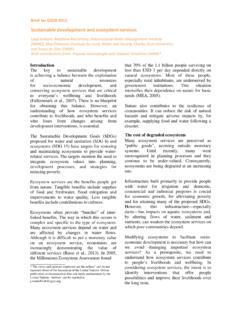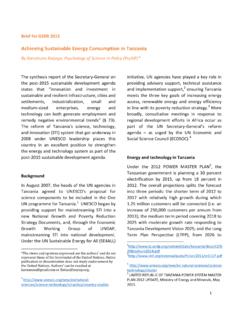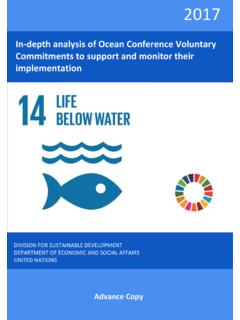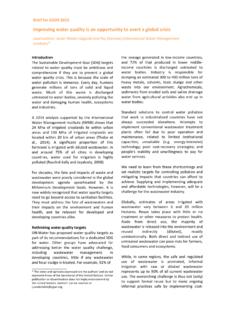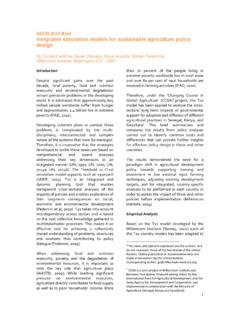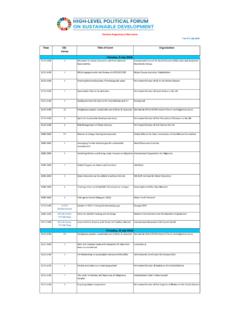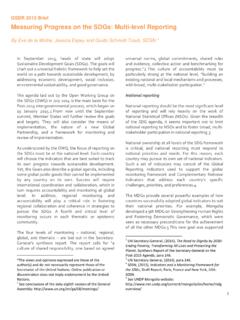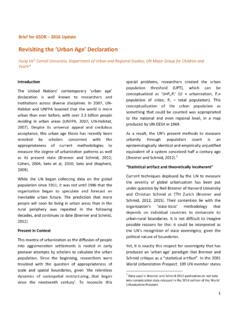Transcription of Sustainable Food and Agriculture: Development in the 21 ...
1 Sustainable food and Agriculture: Development in the 21st century (SD21) The future of sustainability Sustainable food and Agriculture: Development in the 21st century (SD21) The future of sustainability Study prepared by Daniele Giovannucci,1 Sara Scherr, Danielle Nierenberg, Charlotte Hebebrand, Julie Shapiro, Jeffrey Milder, and Keith Wheeler. A prime objective of the report is to stimulate not to end a healthy discussion that integrates and respects diverse world views on food and agriculture. Some sections may be challenging from one or another perspective and we hope that readers will appreciate the evidence and the value of consensus on several key areas. This study is part of the Sustainable Development in the 21st century (SD21) project. The project is implemented by the Division for Sustainable Development of the United Nations Department of Economic and Social Affairs.
2 This publication has been produced with the support of the European Union and the Committee on sustainability Assessment (COSA). The contents of this publication are the sole responsibility of the United Nations Department of Economic and Social Affairs and the authors and do not necessarily reflect the views of the European Union. Suggested citation: Daniele Giovannucci, Sara Scherr, Danielle Nierenberg, Charlotte Hebebrand, Julie Shapiro, Jeffrey Milder, and Keith Wheeler. 2012. food and Agriculture: the future of sustainability . A. strategic input to the Sustainable Development in the 21st Century (SD21) project. New York: United Nations Department of Economic and Social Affairs, Division for Sustainable Development Executive Summary Our population trajectory means that from now to food systems. Rather than simply more production, 2030, the world will need to build the equivalent of we must also consider what would be better.
3 A city of one million people in developing countries, production and better food systems. every five days! There is widespread consensus that, going forward, farmers must produce more food per There are many who advocate a profound re-thinking unit of land, water, and agrochemicals. To do so, of our current models and, to better serve our coming however, they simply cannot continue producing in needs, would re-imagine and transform the world's the same way. They will have to do this while facing major agriculture and food systems, not just tinker climate change, volatility, shifting nutrition needs, and at the margins or modify them incrementally. Recent the increasing scarcity of most of the physical factors decades have seen such re-imagining result in of production. Agriculture is at the threshold of a radical and world-changing innovations in every field necessary paradigm shift.
4 From politics (social network media) to healthcare (nanotech-based diagnostics and drugs) and This paper illustrates how leading thinkers imagine communication (mobile telephony). our future food and agriculture world. It eschews positions and instead invites reasoned discussion. For the first time at a global level, food It cuts across the thought silos intrinsic to different production faces multiple limiting factors for world views and partisan values to identify consensus key resources such as land, water, energy and also disagreement. We solicited input from and inputs. We must use this challenge to leading experts in different dimensions of agriculture, stimulate creative innovation representing the perspectives of the natural and social sciences, developing and developed countries, policy and academia, public and private.
5 Respondents were Main trends and challenges asked about most significant trends and the most important priorities in the next 20 years to ensure There are opportunities and also considerable Sustainable food and agriculture systems. challenges and some are relatively new. For example: We now face astonishing levels of waste, 30 40. Farming has enormous impacts on the world's most percent of all food , and at every step of the food critical resources. Accordingly, farmers will have to cycle. Every year, high percentages of the food produce while also ensuring the provision of various produced in developing countries never makes it vital ecosystem services. If they do not, we will not to market and consumers in rich countries waste only degrade those resources but also exhaust the as much food as the entire net food production of ability to produce enough food .
6 Sub-Saharan Africa. We are aiming at the wrong goal. For the first time These expectations pose quite a challenge and the in history we have as many overweight people as overall outcome depends very much on the response undernourished people and the consequences of of millions of mostly small and medium farmers. The our emerging dietary habits are on a disastrous current more production' orientation is so outdated trajectory for human health and for ecosystem and unresponsive to our current needs that it is causing health. Yet, agriculture policy concentrates mostly its own problems, particularly for our environment on production and trade and is curiously divorced and natural resources. Although food is critical, it is from the vital issues of good nutrition. We need to not just about food . We have a pressing need for new actively shift our focus to two areas: approaches in policies and structures that realistically a) more access since we already have more account for the formidable environmental impacts and than 4000 kcal per person per day in traded consider the social consequences of our evolving agri- foods; and iv food and Agriculture: The future of sustainability b) more nutrition or healthy food because productive lands are lost annually through soil Executive Summary the explosion of empty calories in many erosion and degradation, much of it in developing developing countries reflects the meteoric countries.
7 Besides its production function, rise of the clinically overweight in many agriculture needs to integrate other vital functions industrial economies. of ecosystem management as central features of Despite their increasing importance, the current its Development . trends in livestock and biofuels are likely to contribute to more food -related crises due to their Where will solutions come from? As many inefficient use of food -related resources. governments have retreated from agricultural Pressures on food prices are likely to continue investment there is a shifting re-organization of roles since they are exacerbated by volatile market and of governance from public to private. Clearly, dynamics, inadequate global coordination and private enterprise is a powerful factor, and even more the multiple effects of population growth, energy so with increased concentration all along the supply markets, climate change, land degradation and chain.
8 Firms themselves also face new governance water scarcity. challenges with volatility in supplies and markets Concentration in supply puts us at increasing and increasingly transparent operating and reporting risk. With more than 50,000 edible plants in the conditions. While many firms serve only their private world still, over well half of our food comes from interests, an increasing number of forward-looking only three. Concentration in the number of firms firms recognize the need to create shared value and managing the global distribution of food supplies not just profit if they are to thrive in the long term. How may also contribute to risks. can public governance work with companies to foster Governance is shifting. The main actors are not both public and private benefits? How can we now heading in quite the same direction.
9 Agriculture employ vastly improved methods for measuring and discussions are increasingly oriented toward understanding the impacts we are creating and use ecological approaches that recognize the limits these to evolve new learning pathways for producers, imposed by natural resources and toward improved communities, firms, and policymakers? The public social outcomes. However, many governments, sector must offer a more thoughtful and principled international agencies, multilateral and bilateral guidance that takes into account longer-term public institutions are only beginning to actively invest needs and the private sector will have to be a major in such concepts in agriculture; whereas a few part of the solutions to the new challenges of our food food companies and NGOs are taking the lead and agriculture systems since its future depends on instead.
10 Corporate power has grown to easily rival the sustainability of these systems as well. the influence and effect of the state, changing the dynamics of local and global food systems. In light of the state of agriculture, there is agreement Consequently, we will not advance effectively in a number of important areas even across the unless we address how public policy and private distinctive world views embodied in the four diverse sector investment choices integrate toward a groups that undertook this process: Policy and Trade;. common and shared good. Business Specialists; Rural Livelihoods and Poverty;. Agriculture is one of the biggest threats to a healthy and Environmental sustainability . Being explicit about environment. It uses most of our available fresh both the differences and the areas of consensus water and some 20,000 50,000 km2 of potentially enables us to focus on realistic efforts right now.
